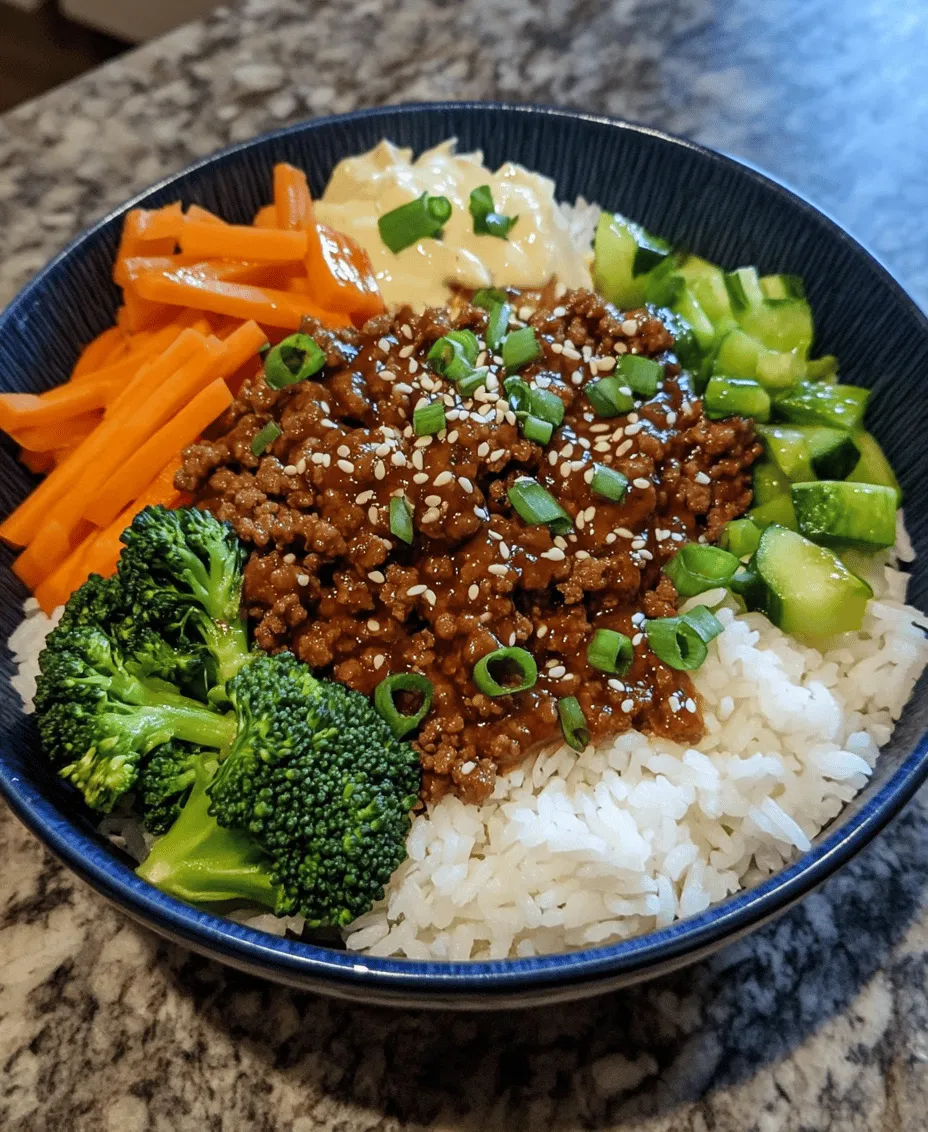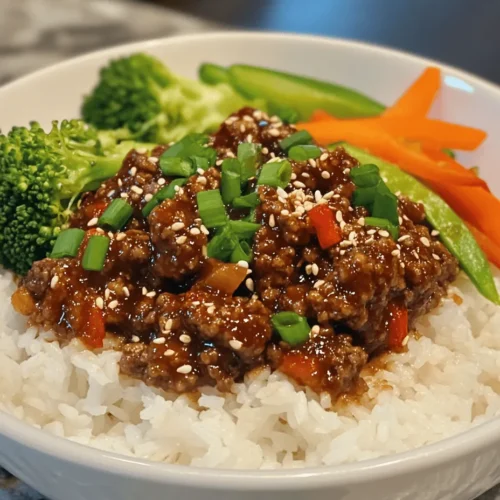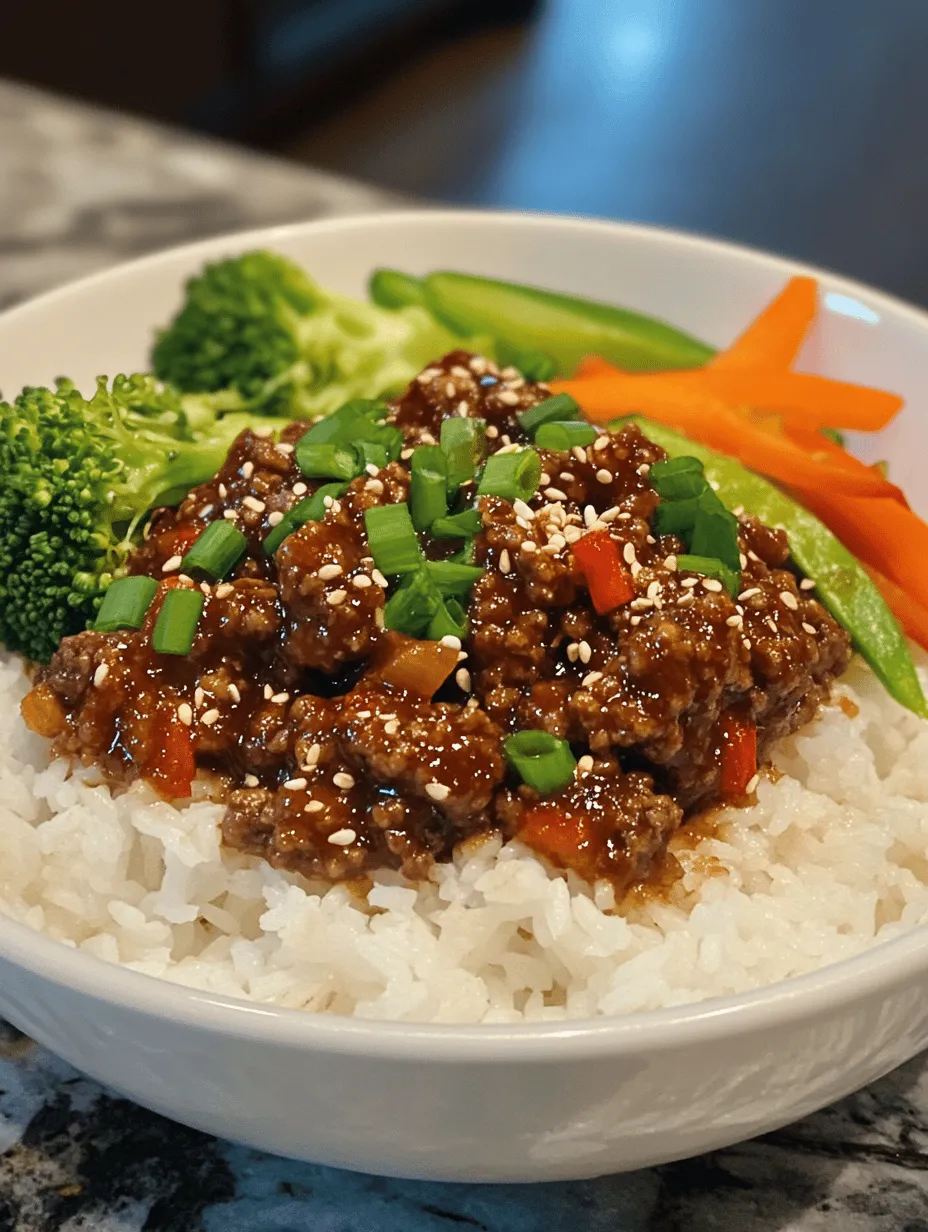Korean cuisine is renowned for its vibrant flavors, delightful textures, and harmony of ingredients that come together to create unforgettable dishes. Among the many culinary treasures from Korea, the Korean Ground Beef Bowl stands out for its simplicity, speed, and delicious balance of savory and sweet elements. This dish offers a satisfying meal that can be whipped up in just 25 minutes, making it perfect for busy weeknights or a quick yet impressive dinner for guests.
The Korean Ground Beef Bowl is not only a feast for the taste buds but also an opportunity to delve into the rich cultural tapestry of Korean cooking. In this article, we will take you through the essential ingredients, preparation steps, and tips for creating the perfect Korean Ground Beef Bowl. Whether you’re a seasoned foodie or a novice cook, this recipe promises to deliver a delightful culinary experience.
Understanding the Ingredients
To create a truly flavorful Korean Ground Beef Bowl, it’s crucial to understand the role of each ingredient in the recipe. The harmony of flavors is what makes this dish truly special.
The Key Ingredients for a Flavorful Dish
1. Ground Beef: The star of the dish, ground beef provides a rich, meaty base that absorbs the flavors of the seasonings and sauce. Opting for lean ground beef not only enhances the dish’s flavor but also keeps it healthier.
2. Sesame Oil: This nutty oil is a staple in Korean cooking. A drizzle of sesame oil adds depth and an authentic flavor, making the dish aromatic and inviting.
3. Garlic and Ginger: These aromatics are fundamental in many Korean dishes. Freshly minced garlic and ginger elevate the overall taste, imparting warmth and zest that complements the beef beautifully.
4. Soy Sauce: A key ingredient that provides umami and saltiness, soy sauce is essential for building the dish’s flavor profile. Opt for low-sodium soy sauce to control salt levels without sacrificing taste.
5. Brown Sugar: This adds a touch of sweetness that balances the savory elements. The molasses in brown sugar enhances the sauce’s depth, giving it a rich, caramelized flavor.
6. Red Pepper Flakes: For those who enjoy a kick of heat, red pepper flakes are a fantastic addition. They can be adjusted according to your spice preference, ensuring everyone can enjoy this dish.
7. Rice Vinegar: This tangy ingredient brightens the flavors and adds a refreshing element to the dish. It cuts through the richness of the beef and balances the sweetness of the brown sugar.
8. Vegetables: Incorporating vegetables like green onions, bell peppers, or broccoli not only adds color and texture but also boosts the nutritional value of the meal.
Nutritional Benefits of the Ingredients
Understanding the nutritional profile of the ingredients can enhance your appreciation for this dish. Lean ground beef is an excellent source of protein, iron, and B vitamins, making it a nourishing choice for a hearty meal. The inclusion of vegetables contributes essential vitamins, minerals, and fiber, promoting overall health.
Sesame oil, while rich in calories, contains healthy fats that can support heart health. Garlic and ginger are not just flavor enhancers; they also possess anti-inflammatory and antioxidant properties. Meanwhile, the brown sugar, when used in moderation, provides a quick source of energy without overloading on refined sugars.
By choosing fresh ingredients and controlling portions, you can enjoy a delicious and health-conscious meal with the Korean Ground Beef Bowl.
Preparation Steps
Now that we understand the importance of each ingredient, let’s dive into the preparation steps for crafting the perfect Korean Ground Beef Bowl. This step-by-step guide will ensure clarity and ease of understanding, making it accessible for cooks of all skill levels.
Step-by-Step Guide to Making Korean Ground Beef Bowl
Step 1: Gather Your Ingredients
Before you start cooking, it’s essential to have all your ingredients ready. This not only streamlines the cooking process but also ensures that you don’t miss any components. Assemble:
– 1 pound of lean ground beef
– 2 tablespoons of sesame oil
– 4 cloves of garlic, minced
– 1 tablespoon of fresh ginger, minced
– 1/4 cup of soy sauce
– 2 tablespoons of brown sugar
– 1 teaspoon of red pepper flakes (adjust to taste)
– 1 tablespoon of rice vinegar
– 1 cup of vegetables (e.g., green onions, bell peppers, or broccoli)
Step 2: Prepare the Sauce
The sauce is the heart of this dish, so it’s crucial to get it right. In a small bowl, combine the soy sauce, brown sugar, red pepper flakes, and rice vinegar. Whisk until the sugar dissolves completely, and set it aside. This sauce will coat the beef and provide an explosion of flavor.
Tip: Taste the sauce before adding it to the beef. Adjust the sweetness or spice level according to your preference to ensure it complements your taste.
Step 3: Cook the Beef
In a large skillet or wok, heat the sesame oil over medium-high heat. Once hot, add the ground beef, breaking it apart with a spatula. Cook the beef for about 5-7 minutes, stirring occasionally until it’s browned and cooked through.
Tip: To achieve the ideal texture, avoid overcrowding the pan. If necessary, cook the beef in batches. Ensure that it’s well-browned for maximum flavor.
Step 4: Add Aromatics
Once the beef is cooked, it’s time to introduce the aromatics. Add the minced garlic and ginger to the skillet, stirring them into the beef. Cook for an additional 1-2 minutes until fragrant, being careful not to let the garlic burn, as this can impart a bitter taste.
Creating the Perfect Sauce
The sauce is what ties all the flavors together in the Korean Ground Beef Bowl. The balance of soy sauce, sugar, and vinegar creates a blend that is both savory and sweet, with a slight tang from the vinegar.
For those who enjoy a little more heat, consider adding extra red pepper flakes or even a splash of Sriracha for a spicy kick. Alternatively, if you prefer a milder flavor, you can reduce the amount of red pepper flakes or omit them altogether.
Tip: If you find the sauce too salty, you can dilute it with a teaspoon of water or add a little more brown sugar to balance it out.
Cooking the Beef to Perfection
Cooking ground beef may seem straightforward, but achieving the perfect texture requires attention to detail. To avoid overcooking, keep an eye on the beef as it browns. You want it to be flavorful and slightly crispy on the edges, which will enhance the overall taste of the dish.
Tip: Drain any excess fat after cooking the beef if you’re using a higher-fat ground beef. This will prevent the dish from becoming greasy.
Incorporating Aromatics for Enhanced Flavor
Garlic and ginger are not just added for their flavor; they play a vital role in enhancing the dish’s overall aroma and taste. As these aromatics cook, they release essential oils that infuse the beef with a warm, inviting scent.
To maximize their impact, consider grating fresh ginger instead of mincing it. This can provide a more intense ginger flavor, which pairs beautifully with the other ingredients.
Tip: If you want to experiment further, you can add other aromatics such as chopped onions or bell peppers during the beef cooking stage for added depth.
Serving Suggestions
Once you have perfected your Korean Ground Beef Bowl, it’s time to consider how to serve it. The choice of rice can significantly enhance the dish, so let’s explore some ideal rice options.
Ideal Rice Choices for Your Bowl
1. White Rice: A classic choice that complements the flavors of the beef. Its neutral taste allows the rich sauce to shine.
2. Brown Rice: For a healthier option, brown rice adds a chewy texture and nutty flavor, along with additional fiber and nutrients.
3. Cauliflower Rice: A low-carb alternative that provides a light and refreshing base for the beef. It absorbs the flavors of the sauce well, making it a great substitute.
4. Sticky Rice: This option offers a unique texture and is commonly used in Asian dishes. It pairs wonderfully with the beef, allowing for easy scooping.
5. Quinoa: For a protein-packed alternative, quinoa can be a fantastic base, providing a nutty flavor and added nutrition.
By selecting the right rice, you can elevate your Korean Ground Beef Bowl and create a meal that is both satisfying and nutritious.
In the next part of this article, we will explore variations of the Korean Ground Beef Bowl, additional serving suggestions, and tips for customizing the dish to suit your tastes. Stay tuned as we continue our culinary journey through this delightful Korean classic!

Vegetable Variations
When it comes to creating a Korean Ground Beef Bowl, the choice of vegetables can elevate the dish both nutritionally and visually. While the foundational ingredients provide a solid base, adding a variety of colorful vegetables not only enhances the dish’s appeal but also boosts its health benefits. Here are some excellent vegetable options to consider:
1. Steamed Broccoli: This nutrient powerhouse is rich in vitamins C and K, and when lightly steamed, it retains a vibrant green color and a satisfying crunch that complements the savory beef. Broccoli’s slight bitterness balances the sweetness of the sauce, creating a harmonious flavor profile.
2. Bell Peppers: Available in a rainbow of colors, bell peppers add a sweet, crisp texture that brightens up the bowl. They are also an excellent source of vitamin A and antioxidants, making them a fantastic addition for both taste and health.
3. Snap Peas: With their sweet flavor and satisfying snap, snap peas bring a refreshing crunch to the dish. They are low in calories but high in fiber, which contributes to a feeling of fullness. Their bright green color enhances the visual appeal of the bowl.
4. Carrots: Shredded or sliced, carrots can add a delightful sweetness to your Korean Ground Beef Bowl. They are rich in beta-carotene, fiber, and antioxidants. A quick sauté or steam can soften them slightly while still maintaining their vibrant hue.
5. Zucchini: Thinly sliced or spiralized, zucchini offers a mild flavor that absorbs the savory sauce beautifully. It adds a lovely texture and is a low-calorie vegetable option that complements the dish without overpowering it.
By incorporating a mix of these vegetables, you can create a well-rounded, colorful bowl that is as pleasing to the eye as it is to the palate.
Garnishing for Enhanced Visual Appeal
Garnishing your Korean Ground Beef Bowl is an essential step that enhances both its presentation and flavor. The two most common garnishes are green onions and sesame seeds, each contributing to the dish in unique ways.
– Green Onions: Chopped green onions add a fresh, mild onion flavor that cuts through the richness of the beef. Their vibrant green color provides a pop of contrast against the brown beef and colorful vegetables. Scatter them liberally over the bowl just before serving for an inviting look.
– Sesame Seeds: Toasted sesame seeds add a nutty flavor and textural contrast to the dish. They not only enhance the visual appeal with their delicate, speckled appearance but also provide healthy fats and protein. A light sprinkle of sesame seeds over the top completes the dish, giving it an authentic Korean touch.
Taking the time to garnish your Korean Ground Beef Bowl not only elevates the dish aesthetically but also enhances the overall eating experience. It’s these small details that can turn a simple meal into a special one.
Variations of the Korean Ground Beef Bowl
To keep your Korean Ground Beef Bowl exciting and adaptable to various tastes, consider these delightful variations:
Spicy Korean Ground Beef Bowl
For those who crave a bit of heat, introducing spices or hot sauces can transform your dish into a Spicy Korean Ground Beef Bowl. You can add:
– Gochujang: This Korean chili paste is a staple in many Korean dishes and can be mixed into the beef while cooking. It adds depth, heat, and a touch of sweetness that pairs beautifully with the soy sauce.
– Red Pepper Flakes: A sprinkle of red pepper flakes can elevate the spice level without overwhelming the other flavors. Start with a small amount and adjust to your desired heat.
– Sriracha: Drizzle sriracha on top of the finished bowl for an immediate kick. It also adds a lovely red color that enhances the dish’s visual appeal.
Vegetarian or Vegan Alternatives
For those looking to enjoy a plant-based version of this dish, there are several excellent alternatives to ground beef:
– Tofu: Firm or extra-firm tofu can be crumbled or diced and sautéed in the same way as beef. Marinate the tofu in the same sauce for a flavor-packed vegetarian option.
– Tempeh: This fermented soybean product has a nutty flavor and a firm texture, making it a great substitute for ground beef. Crumble it and sauté with the sauce for a hearty, protein-rich meal.
– Mushrooms: Chopped mushrooms, particularly shiitake or portobello, can provide a meaty texture and umami flavor that resembles ground beef. Sauté them until browned for an earthy addition to your bowl.
These plant-based alternatives not only cater to vegetarian and vegan diets but also add unique flavors and textures to the dish.
Gluten-Free Adaptations
For those with gluten sensitivities or celiac disease, it’s essential to make sure your Korean Ground Beef Bowl is gluten-free. Here are some easy substitutions:
– Tamari: This soy sauce alternative is naturally gluten-free and can be used in the same proportion as soy sauce in the recipe. It offers a similar flavor profile without the gluten.
– Coconut Aminos: This soy sauce substitute made from fermented coconut sap is also gluten-free and has a slightly sweeter taste. It’s a fantastic option for those looking to reduce soy in their diet.
By making these simple substitutions, you can enjoy a deliciously flavorful Korean Ground Beef Bowl that caters to gluten-free dietary needs.
Tips for Perfecting Your Korean Ground Beef Bowl
To ensure your Korean Ground Beef Bowl turns out perfectly every time, consider the following tips:
Common Mistakes to Avoid
1. Overcooking the Beef: Ground beef cooks quickly, and overcooking can lead to dry, tough meat. Aim for a medium-high heat and cook until just browned for the best texture.
2. Skipping the Marinating Step: Allowing the beef to marinate in the sauce for at least 30 minutes (or even overnight) amplifies the flavor. Don’t skip this step if you want a rich, delicious taste.
3. Using Stale Ingredients: Fresh ingredients make a significant difference in flavor. Always opt for fresh vegetables and quality beef to elevate your dish.
Enhancing Flavor with Marinades
Marinating your ground beef is a simple yet effective way to enhance the overall flavor of your Korean Ground Beef Bowl. Here’s a quick marinade recipe:
– ¼ cup soy sauce or tamari
– 1 tablespoon brown sugar
– 1 tablespoon sesame oil
– 2 cloves garlic, minced
– 1 teaspoon ginger, minced
Combine these ingredients and let the ground beef soak up the flavors for at least 30 minutes before cooking. The result will be a tender, flavorful beef that shines in your bowl.
The Importance of Fresh Ingredients
Using fresh ingredients is crucial for achieving the best flavor and texture in your Korean Ground Beef Bowl. Fresh vegetables maintain their crunch and vibrant colors, while fresh ground beef has better flavor and moisture. Always check for freshness when shopping, and try to source local produce when possible. The better the ingredients, the more satisfying the dish will be.
Conclusion
The Korean Ground Beef Bowl is not only a quick and easy meal option but also a versatile dish that can be tailored to suit various dietary preferences and tastes. With its rich umami flavors and vibrant colors, this recipe is sure to please anyone at the dining table. By following the detailed preparation steps and exploring the suggested variations, you can create a unique and satisfying meal that celebrates the essence of Korean cuisine.
Enjoy the process of cooking and the delightful flavors that come together in this incredible dish! Whether you opt for the classic beef version or experiment with vegetarian alternatives, your Korean Ground Beef Bowl is bound to be a hit. So gather your ingredients, unleash your creativity, and savor the satisfaction of a homemade bowl that warms the heart and delights the palate.



